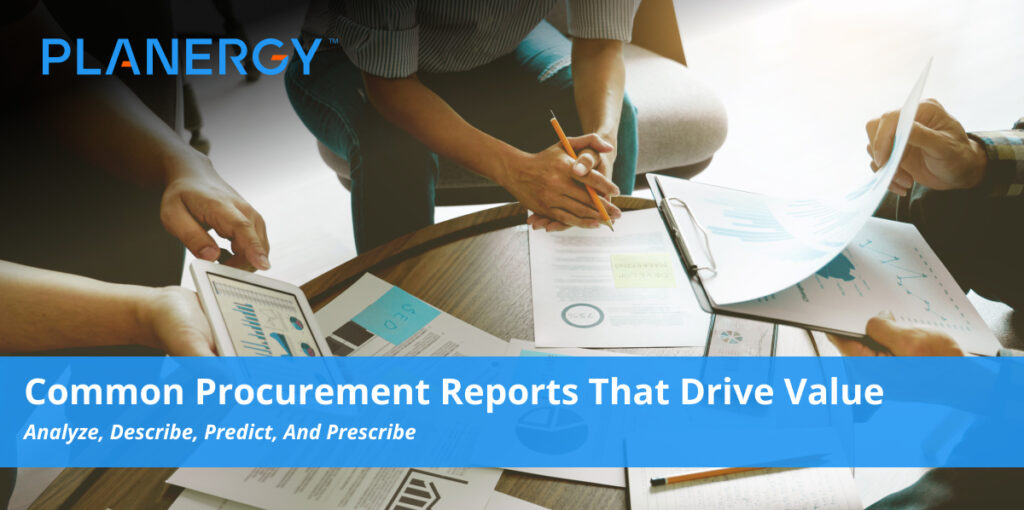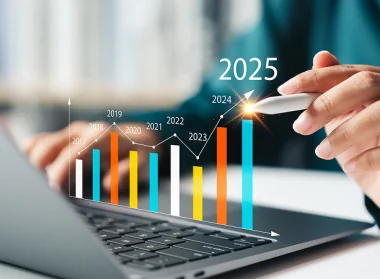The procurement department is quickly becoming a key player in building and maintaining growth, value, and competitive strength for businesses in all industries. Companies are eager to tap into the powerful insights hidden within their procurement data in order to make better business decisions, and rely on data-driven procurement tools to reveal and leverage those insights appropriately.
Common procurement reports are some of the most powerful and basic tools available to chief procurement officers (CPOs) and other procurement leaders as they align procurement strategy with organizational goals and seek to center their departments as value creators. With a thorough understanding of what these reports are and how they work, procurement teams can achieve significant cost reduction and create a cascading chain of value throughout their organizations.
Common Procurement Reports: Overview
Procurement departments use procurement reporting (called eProcurement reporting when performed using digital tools and using digital sources) to refine the raw ore of spend data into polished ingots of actionable insights. Reports are any document providing useful information. They combine text with tables and graphics to make the data more readily digestible.
Procurement reports are most often generated on a periodic basis, but organizations who’ve invested in procure-to-pay optimization software can generate them easily on demand.
Some of the most common types of eProcurement reports include:
- Spend reports help with budgeting, audits, and reporting, with versatile levels of granularity based on context. They can be used to compare actual spend to approved budgeted values, get a clear picture of the company’s overall financial footing in real time, help with cash flow management, and more.
- Supplier base reports help track the details of how much is being spent with which suppliers, as well as approvals, inventory and usage statistics, etc. These reports are most useful when all spend information is available, from the original purchase requisition to the final supplier invoice confirmation and payment. By tracking spend related to each vendor in the supply chain, companies can improve their sourcing strategies to streamline their supply chains for resilience and flexibility while still capturing cost savings and protecting business continuity.
- Category analysis reports are a specific type of supplier report. By sorting, managing, and analyzing data for materials, goods, and services via category management, companies can gain a much richer understanding of spend, more effectively monitor supplier performance and compliance, and seize opportunities to invest in innovation and growth.
- Accounts payable (AP) reports contain valuable information related to spend activity, providing accurate figures for committed spend, accruals, goods received but not invoiced (GRNI), etc. The more accurate and complete a company’s procurement data is, the more useful it will be downstream for AP in generating reports and forecasts of their own.
- Contract management reports present analyses of supplier contracts and relevant ancillary data, as well as compliance and performance information. They provide additional guidance in trimming bloat from the supply chain, adding necessary context-relevant redundancies, and identifying opportunities to partner with the company’s best suppliers on mutually beneficial initiatives.
- Procurement benchmarking reports examine actual performance against internal benchmarks, industry standards, peer performance, etc.
- Savings lifecycle analysis reports are used to evaluate the effectiveness and efficiency of cost savings initiatives over their total lifespan.
In the past, procurement analysis was performed primarily by business analysts specializing in spend analysis, using Microsoft Excel spreadsheets, paper documents, and manual workflows. Over time, the process has evolved to match available technology.
The Value of Procurement Analytics
Typically, eProcurement reports use procurement analytics to contextualize information. Also called spend analytics, they reveal patterns, problems, and potential opportunities hidden within procurement data and are used to create a procurement strategy that addresses all three.
In the past, procurement analysis was performed primarily by business analysts specializing in spend analysis, using Microsoft Excel spreadsheets, paper documents, and manual workflows.
Over time, the process has evolved to match available technology. Automation and analytics have replaced pen, paper, and tedious, error-riddled manual processes.
Today, a company implementing a best-in-class, centralized procure-to-pay solution such as PLANERGY has access to:
- Advanced procurement analytics powered by artificial intelligence (AI)—specifically, machine learning that improves performance and accuracy over time.
- A diverse set of data sources, fully integrated within a central data management platform.
- Process automation to improve functionality, speed, and accuracy while eliminating delays and human error.
- Real-time visibility into spend data for more timely and accurate forecasting and reporting.
- Report templates for greater speed, convenience, and accuracy.
- Speed, safety, and reliability thanks to Software-as-a-Service (SaaS) delivery, built-in data encryption, and mobile-friendly, secured access.
Types of Procurement Analytics
Procurement analytics take various forms fall broadly into four categories of spend analysis:
- Diagnostic analytics are used to mine existing historical data to help procurement leaders:
- Understand long-term trends;
- Examine the nature of unaddressed challenges and unexploited opportunities;
- Develop new procurement strategies and forecasts informed and enhanced by understanding this historical data to boost value, performance, compliance, savings, and profitability.
- Descriptive analytics are the “what” to diagnostic analytics’ “why and how.” They describe past performance in intricate detail.
- Predictive analytics are future-focused. Descriptive analytics provide a clear and transparent understanding of past data; diagnostic analytics mine the data so clarified for insights; and predictive analytics use those insights in forecasting future procurement performance.
- Prescriptive analytics are the “solutions” phase of analysis. Using analyzed procurement data and the forecasting models developed from it, CPOs and other procurement leaders can make more strategic, timely, and value-focused business decisions with confidence.
Analytics capture data from a broad and diverse set of sources, both internal and external.
These include:
- Procurement-focused key performance indicators (KPIs) and other metrics being tracked by the organization, such as:
- Total cost of ownership;
- Spend under management;
- Bottom line gains achieved via both cost savings and cost avoidance.
- Supplier availability;
- Supplier defect and compliance rates;
- Purchase order cycle time;
- Average cost of processing a purchase order.
- Performance management benchmarks for internal controls and workflows.
- Input from other applications in the company’s software environment, including:
- Accounting software;
- Enterprise resource planning (ERP) suites;
- Office applications such as Microsoft Excel and Access;
- Customer relationship management (CRM) platforms.
- Diverse external data sources, including:
- General Internet-based information, e.g. currency rates, market trends, commodity information.
- Proprietary industry, market, and financial information.
- Supplier industry codes.
- Credit rating information.
- Risk exposure profiles.
- Industry or government compliance updates.
- Social media, mainstream media updates, and direct consumer feedback relevant to issues such as sustainability and ethical business practices and their impact on the price and use of materials, services, etc.
Any given procurement report will likely include analyses drawn from all four categories, and will ideally be built using as much relevant information as is available. Clean, accurate, and complete data from optimized procurement processes provides the best, most strategically useful insights that are so essential to strategic planning and decision making.
Procurement Analysis: Turning Data into Procurement Reports
The actual analysis process is fairly straightforward. But in examining its particulars, it quickly becomes clear just how important digital tools such as artificial intelligence and automation are to getting optimal results.
Phase One: Extract the Data
Drawing from all available sources, the data is collected, organized, and consolidated into a single central database. This data in this phase is the “raw ore,” ready to be refined into insights and information that’s readily absorbed and put to strategic use.
Phase Two: Clean, Categorize, and Enrich the Data
In this phase, the data is standardized and organized, eliminating file format conflicts, removing errors and redundancies, and enhanced through enrichment tools such as translation (e.g., between languages) or conversion (e.g., to a single currency).
Phase Three: Analysis and Reporting
Cleaned, organized, and readily accessible, the data is now ready to be analyzed. The resulting insights can be further organized into reports using text, graphics, and tables, and provide as much or as little granularity as is desired.
Best Practices for Procurement Reporting
Investing in a purpose-built P2P solution is the best first step you can take for optimal cost savings and value creation through procurement reporting.
The best second step is understanding how to structure reporting and manage your data to maximize those savings and value.
Procurement teams can further improve their results by following a few basic best practices.
1. Consider How Procurement Provides Value to Your Organization
Companies who are actively repositioning procurement to drive value via enterprise-wide process optimization and spend control will have a somewhat different approach than those who rely on it for strategic guidance and holistic value creation rather than cost alone.
In clarifying the procurement department’s role in the organization and the best way to leverage procurement reporting, it’s helpful to ask:
- What is procurement’s current strategic role in the organization? Strictly “back office” or “spend cops”, or has the company already altered its business processes to incorporate procurement data as part of its strategic planning?
- Is procurement responsible for the bulk of direct and indirect spend for the organization?
- Is the company a manufacturer? Retailer? Service-based?
- How collaborative is procurement with the internal stakeholders that serve as its customers?
- What is the existing level of collaboration present between members of the C-suite and the business functions they lead?
- How significant would the damage to the bottom line and business continuity be if procurement and its supply chain were cataclysmically disrupted?
The answers to these questions will help guide you as you craft your reporting structure. For example, a business that relies heavily on procurement to protect both business continuity through the supply chain and the bottom line through cost savings and value will benefit from direct reporting to the chief executive officer (CEO) or chief operations officer (COO) as well as the CPO, and prioritizing enterprise goals.
On the other hand, companies where procurement provides strategic guidance and a strong relationship with internal stakeholders might provide value and savings through optimizing spend managed by its customers and prioritizing more effective budgeting and forecasting for reporting to the CPO.
2. Prioritize Spend Transparency
When you have real-time visibility into all of your spend data, it’s much easier to manage everything from cash flow to the procure-to-pay process. Procurement organizations who make transparency a priority will reap the benefits in more strategically useful insights and reporting.
- Set and enforce clear procurement policies.
- Document and monitor all phases of the source-to-pay process, using KPIs to set benchmarks and modify processes as necessary.
- Practice proactive, communicative, and collaborative supplier relationship management, contract management, and supplier management. Miscommunication and lack of visibility into all areas of your sourcing can lead to costly errors that increase total cost of ownership and eliminate opportunities to capture savings or build value.
- Make process and data auditing part of your regular workflows to keep data clean and ensure small complications or errors don’t become major financial or operational headaches.
Transform Procurement Data into Value and Savings
Every day, your procurement activities generate a wealth of data. Shouldn’t you be putting it to good use? It’s time to separate the strategic wheat from the chaff when harnessing the power of your procurement data.
Invest in the procurement software tools you need for access to top-tier data management, procurement analytics and reporting, and comprehensive spend management. The insights you uncover will help you optimize your processes, provide invaluable data for accounts payable reporting, and drive value and savings throughout your organization through more strategic sourcing and spending.




